'A bewildering darkness...'
Published: 17 September 2002
Puffins have returned to breed on Ailsa Craig for the first time in fifty years
A University of Glasgow project has successfully eradicated rats from Ailsa Craig allowing puffins to breed for the first time in fifty years. The project began in 1991 in collaboration with the island's owner The Marquess of Ailsa and Scottish Natural Heritage with advice from Rentokil, the pest control company.
Rat predation had substantially reduced several seabird populations on Ailsa Craig, most notably the puffin which is particularly vulnerable due to its burrow nesting. Ailsa Craig was once a major stronghold of the puffin on the west coast of Scotland. When in flight over the island in the 1870's, their huge numbers were said to cause ' a bewildering darkness'.
Following invasion of Ailsa by brown rats in the late 19th century, puffin numbers declined from many tens of thousands to only a few hundred by the 1930's. No puffins have successfully bred on Ailsa for over 50 years.
Dr Bernard Zonfrillo of the University who has studied the seabirds on Ailsa Craig for over twenty years said,
'It is just wonderful to see the puffins back breeding on the island. At least two pairs were seen carrying fish to their chick on Ailsa Craig this summer. Given time and left to their own devices, I hope that their numbers will gradually increase.'
In a massive operation, several tons of rodenticide was airlifted by Navy helicopter to the island and distributed by a team of workers. Follow up baiting took place in 1992 and no rats have been recorded on the island since then.
Professor Pat Monaghan, University of Glasgow, Division of Environmental and Evolutionary Biology, commented,
'The return of burrow nesting seabirds like the puffin is just hat we had hoped would happen following rat eradication. The loss of bio-diversity that occurs when predators like rats are introduced to offshore islands is tragic. Seabirds originally bred on such offshore islands because they were free of predators like rats.'
The first rat was seen on Ailsa Craig in 1889 around the time of construction of a new lighthouse. It is thought to have either escaped from ships bringing coal or possibly from the number of ships wrecked on the rocks before the lighthouse was built.
Media Relations Office (media@gla.ac.uk)
Please contact the Press Office on 0141 330 3535 if you wish to speak to Professor Monaghan or Dr. Zonfrillo.
First published: 17 September 2002
<< September


